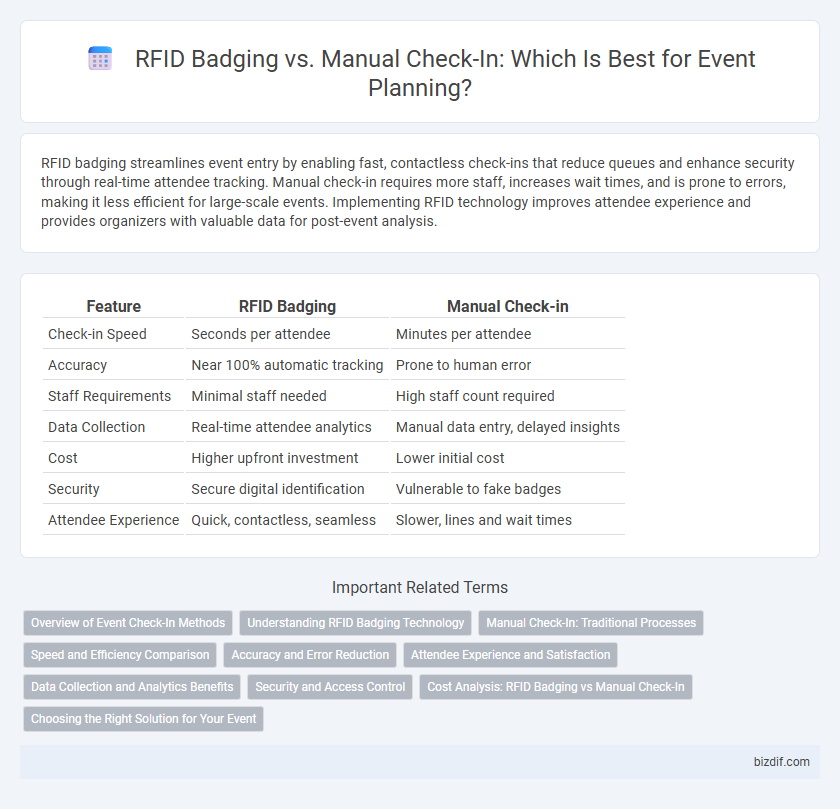RFID badging streamlines event entry by enabling fast, contactless check-ins that reduce queues and enhance security through real-time attendee tracking. Manual check-in requires more staff, increases wait times, and is prone to errors, making it less efficient for large-scale events. Implementing RFID technology improves attendee experience and provides organizers with valuable data for post-event analysis.
Table of Comparison
| Feature | RFID Badging | Manual Check-in |
|---|---|---|
| Check-in Speed | Seconds per attendee | Minutes per attendee |
| Accuracy | Near 100% automatic tracking | Prone to human error |
| Staff Requirements | Minimal staff needed | High staff count required |
| Data Collection | Real-time attendee analytics | Manual data entry, delayed insights |
| Cost | Higher upfront investment | Lower initial cost |
| Security | Secure digital identification | Vulnerable to fake badges |
| Attendee Experience | Quick, contactless, seamless | Slower, lines and wait times |
Overview of Event Check-In Methods
RFID badging streamlines event check-in by enabling fast, contactless scanning that reduces wait times and improves attendee tracking accuracy. Manual check-in relies on paper lists or basic digital logs, leading to slower processing and higher potential for errors or bottlenecks. Leveraging RFID technology enhances data collection and security compared to traditional methods, optimizing overall event management efficiency.
Understanding RFID Badging Technology
RFID badging technology streamlines event check-in by using radio frequency identification to quickly and accurately verify attendees, reducing wait times and minimizing human error compared to manual check-in methods. This technology enables real-time tracking of attendee movement and enhances security by preventing badge duplication or fraud. Integrating RFID badging improves data collection for event analytics, leading to a more efficient and personalized attendee experience.
Manual Check-In: Traditional Processes
Manual check-in relies on paper lists or spreadsheets, requiring staff to verify attendee identities and record arrivals by hand. This traditional process often causes longer wait times and increases the risk of human error, such as misrecording or losing data. Despite being less technologically advanced, manual check-in remains favored for smaller events with limited budgets and simple attendance tracking needs.
Speed and Efficiency Comparison
RFID badging significantly accelerates event check-in by enabling contactless scanning, reducing wait times to mere seconds per attendee compared to manual check-in, which often requires multiple minutes due to manual data entry and verification. Automated data capture through RFID minimizes errors and streamlines attendee flow, enhancing overall operational efficiency during peak entry periods. Event planners leveraging RFID technology can process larger crowds faster, improving attendee satisfaction and resource allocation.
Accuracy and Error Reduction
RFID badging significantly improves accuracy and error reduction in event planning by automating attendee check-ins, minimizing human input mistakes common in manual processes. This technology enables real-time data capture and seamless verification, ensuring precise tracking of participants and eliminating risks of duplicate or missed entries. Events utilizing RFID experience enhanced operational efficiency and more reliable attendance data compared to traditional manual check-in methods.
Attendee Experience and Satisfaction
RFID badging streamlines the check-in process, significantly reducing wait times and minimizing errors compared to manual check-in, which enhances overall attendee experience and satisfaction. The technology enables seamless access control and real-time tracking, allowing event organizers to offer personalized interactions and efficient crowd management. Manual check-in often leads to longer queues and increased frustration, negatively impacting attendees' perceptions and engagement levels.
Data Collection and Analytics Benefits
RFID badging significantly enhances data collection by automatically tracking attendee movements and session participation with high accuracy, enabling real-time analytics. This technology delivers comprehensive insights into attendee behavior and engagement patterns that manual check-in methods cannot capture reliably. Event organizers can leverage this data to optimize event flow, improve targeted marketing, and measure ROI more effectively.
Security and Access Control
RFID badging enhances security by enabling real-time access control and reducing the risk of unauthorized entry through encrypted, tamper-proof badges. Unlike manual check-in, which relies on human oversight and can result in bottlenecks or errors, RFID systems automate identity verification and seamlessly track attendee movements. This technology also allows event organizers to quickly isolate restricted areas and monitor access logs, ensuring stricter control and improved safety during events.
Cost Analysis: RFID Badging vs Manual Check-In
RFID badging reduces long-term labor costs by automating attendee check-in and minimizing errors, while manual check-in requires significant staff hours and resources for data entry and verification. Initial investments in RFID technology include badge printing, readers, and software integration, but these costs are offset by faster processing times and enhanced data accuracy. Manual check-ins might appear cheaper upfront but can lead to higher operational expenses and inefficiencies during large-scale events.
Choosing the Right Solution for Your Event
RFID badging streamlines event check-in by enabling fast, contactless access and real-time attendee tracking, significantly reducing wait times and improving security. Manual check-in may be more cost-effective for small events but often leads to longer lines and increased human error. Selecting the right solution depends on event size, budget, and the desired attendee experience.
RFID badging vs manual check-in Infographic

 bizdif.com
bizdif.com